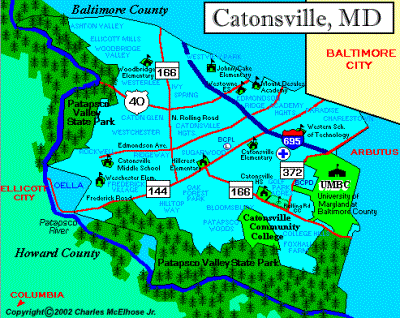Catonsville

|
Catonsville, Maryland, USA
Catonsville is a census-designated place (CDP) in Baltimore County, Maryland, United States. The population was 39,820 at the 2000 census. Catonsville is bordered by Woodlawn to the north, by Baltimore to the east, by Elkridge to the south, and by Ellicott City to its west. Catonsville is the home of University of Maryland, Baltimore County (UMBC), a public research university with over twelve thousand students.
 
Europeans were the second group to settle the area now known as Catonsville. It is generally believed by historians that native tribes, known as the Piscataway, established villages here before the European colonists arrived. This tribe occupied the land between the Potomac to the Chesapeake Bay and up the Patapsco River. Catonsville was located along the Piscataway Trail. The colonists and the tribes got along until the mid-17th century, when the English government ended the practices of Catholic Missionaries in the area. It is believed that the tribes were driven from their villages and some were hunted by slave catchers. As happened in many areas of the early colonial America, diseases unknown to the tribes were spread by the colonists. Eventually, the tribes moved north under the protection of the Iroquois.
  With most of the natives scattered, the colonists expanded across Maryland. Present day Catonsville was settled in the 18th century. In the early 19th century, a county road along the Patapsco River—named the Frederick Turnpike, later designated Route 144 - was opened by the Ellicott family to service traffic between their flour mill, Ellicott Mills, and Baltimore. Catonsville as we know it today was settled along this route by Richard Caton, under the authority of his father-in-law Charles Carroll, a signer of the Declaration of Independence. Travelers along "the turnpike" (as it was then known) rested and conducted business in the area, causing Catonsville to grow. The town lies at thirty nine degrees, sixteen minutes point two six North and seventy six degrees forty four minutes point one seven West.
  The large Victorian and Colonial homes
located in Catonsville were built by wealthy Baltimoreans. Originally, these
communities were used as summer residences to escape the heat in Baltimore.
Eventually, as in many communities with the introduction of the automobile and
electric trolley, families began to reside in Catonsville year round. Baltimore
has attempted over the years to annex Catonsville, the last attempt in 1918, but
all attempts were rebuffed. The community remains an unincorporated town in
Baltimore County. It is home to Spring
Grove Hospital Center, the nation's second oldest continuously
operating psychiatric hospital, as well as the University
of Maryland, Baltimore County. Catonsville was briefly made quite famous during the 1968 protest by the "Catonsville Nine", during which draft records were burned by Catholic anti-war activists. In 2002, the Maryland legislature issued a proclamation declaring Catonsville to be "Music City, Maryland" due to a concentration of musical retail stores, venues and educational facilities in the area. In 2007 Money magazine ranked Catonsville the 49th best place to live in the USA, third best in Maryland and Virginia. Catonsville is a terminus of the Trolley Line Number 9 Trail.
 
ALL IN ALL A LOVELY PLACE TO VISIT WITH REALLY FRIENDLY PEOPLE |



